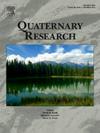气候和洞穴环境对水滴荧光有机质的影响及其对石笋荧光层合的影响
IF 1.8
3区 地球科学
Q3 GEOGRAPHY, PHYSICAL
引用次数: 2
摘要
洞穴荧光可以提供对过去植被动态和石笋年代学的见解。然而,它的起源,特别是在石笋中荧光层状的形成却知之甚少。我们对伊比利亚半岛北部的La Vallina洞穴进行了为期一年的滴漏水荧光监测,并将结果与同一地点的滴漏水化学和活性洞穴元素进行了比较。采用荧光光谱法和平行因子分析法(PARAFAC)对滴落水进行分析。由此产生的五组分模型表明植被、微生物活动和基岩的贡献。位点内荧光变异主要受上覆植被、蓄水时间和呼吸速率的影响。与流行的观点相反,我们发现在降雨条件下滴落点的滴落水荧光没有系统的增加,在当今洞穴层形成的位置,滴落水荧光没有季节性变化。我们的研究结果挑战了雨季腐殖质样荧光丰度较高是层形成的主要原因的概念,并建议对滴水荧光进行额外的控制,如基岩相互作用和微生物再处理。我们还提出生长速度可能控制了石笋荧光信号的扩张,这表明荧光层形成的其他潜在机制。本文章由计算机程序翻译,如有差异,请以英文原文为准。
Climatic and cave settings influence on drip water fluorescent organic matter with implications for fluorescent laminations in stalagmites
Abstract Speleothem fluorescence can provide insights into past vegetation dynamics and stalagmite chronology. However, its origin and especially the formation of fluorescent laminations in stalagmites are poorly understood. We conducted a year-long monthly monitoring of drip water fluorescence in La Vallina Cave (northern Iberian Peninsula) and compared the results to drip water chemistry and active speleothems from the same sites. Drip waters were analyzed using fluorescence spectroscopy and parallel factor analysis (PARAFAC). The resulting five-component model indicates contributions from vegetation, microbial activity, and bedrock. Intra-site fluorescence variability is mainly influenced by changes in overlying vegetation, water reservoir time, and respiration rates. Contrary to prevailing views, we find no systematic increase in drip water fluorescence during rainy conditions across drip sites and seasonal variations in drip water fluorescence are absent at a location where present-day speleothem layers form. Our findings challenge the notion of a higher abundance of humic-like fluorescence during the rainy season as the primary cause for layer formation and suggest additional controls on drip water fluorescence, such as bedrock interaction and microbial reprocessing. We also propose that growth rate may control the dilation of the fluorescence signal in stalagmites, indicating other potential mechanisms for fluorescent layer formation.
求助全文
通过发布文献求助,成功后即可免费获取论文全文。
去求助
来源期刊

Quaternary Research
地学-地球科学综合
CiteScore
4.70
自引率
8.70%
发文量
57
审稿时长
3 months
期刊介绍:
Quaternary Research is an international journal devoted to the advancement of the interdisciplinary understanding of the Quaternary Period. We aim to publish articles of broad interest with relevance to more than one discipline, and that constitute a significant new contribution to Quaternary science. The journal’s scope is global, building on its nearly 50-year history in advancing the understanding of earth and human history through interdisciplinary study of the last 2.6 million years.
 求助内容:
求助内容: 应助结果提醒方式:
应助结果提醒方式:


